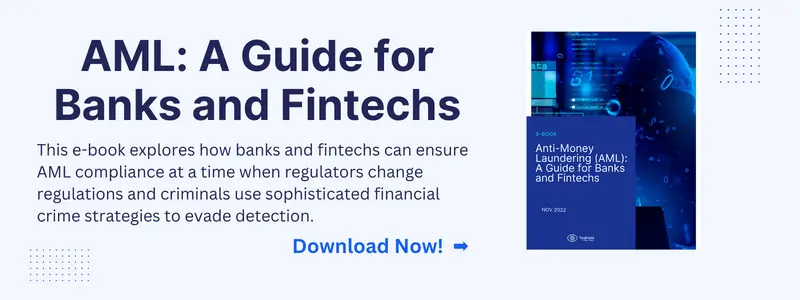Navigating Reputational Risk: Prevention and Management Insights
In the complex web of global finance, the reputational risk faced by financial institutions not only influences their market position but can also have profound implications on their operational viability and regulatory compliance.
This blog explores the nuanced realm of reputational risk—its origins, impacts, and management strategies—with a specific focus on mitigating risks associated with fraud and money laundering. As financial crime compliance professionals, understanding and managing reputational risk is paramount to safeguarding the integrity and value of your institution.
What Is Reputational Risk?
Reputational risk refers to the potential for serious harm to an organization's standing or prestige, which can result in financial, strategic, and operational repercussions. In the financial services sector, this type of risk is particularly critical because trust and credibility are fundamental to customer relationships and regulatory compliance. It emerges not only from actual financial mismanagement or legal violations but also from the perception or expectation of such.
At its core, reputational risk is about the gap between the public's expectations of an organization and their actual experiences or perceptions of the organization's conduct. This gap can be widened by various triggers, ranging from tangible operational failures to more subjective interpretations of a company’s ethical stance or market behavior. For instance, a bank might suffer reputational damage if it is seen as handling customer data carelessly, even if no actual breach occurs.
The implications of reputational risk are extensive. A tarnished reputation can lead to a domino effect of declining customer trust, withdrawal of investor confidence, difficulty in securing funding, and increased scrutiny from regulators and media. Furthermore, in today's digital age, information spreads rapidly and widely, exacerbating the potential speed and scale of reputational damage.
What are the Causes of Reputational Risk?
Reputational risk can originate from various sources, both internal and external, and can be magnified by the interconnected nature of today’s global financial systems. Understanding these sources is the first step toward effective risk management.
Sources of Reputational Risk
- Regulatory Breaches: Non-compliance with legal and regulatory standards can have severe reputational consequences. This is particularly pertinent in the financial sector, where compliance with anti-money laundering (AML) and countering financing of terrorism (CFT) regulations is critical. Failures in these areas can lead to fines, sanctions, and a loss of public trust.
- Operational Failures: These can include system outages, security breaches, or errors in customer account management. Such incidents can disrupt customer service and lead to dissatisfaction, eroding trust and loyalty.
- Poor Corporate Governance: Inadequate oversight and unethical behavior by senior management can lead to scandals that damage a company's reputation. This can include anything from executive misconduct to flawed business strategies that lead to publicized financial losses.
- Cybersecurity Threats: As financial institutions increasingly rely on digital platforms, the risk of cybersecurity breaches grows. Such breaches not only compromise customer data but also significantly harm the institution's credibility.
- Negative Publicity: This can arise from various scenarios, including unsatisfactory customer service, association with controversial events or entities, or media exposés. Even if the negative publicity is based on misinformation, the damage to the organization's reputation can be immediate and severe.
- Environmental, Social, and Governance (ESG) Issues: Increasingly, companies are judged on their sustainability practices and social responsibility. Failures in these areas can attract negative attention from activists, regulatory bodies, and the public.
The Impact of Reputational Risk
The consequences of reputational damage can be profound and wide-ranging, affecting nearly every facet of a financial institution's operations. Understanding these impacts is crucial for developing effective strategies to mitigate and manage reputational risks.
- Loss of Customer Trust and Loyalty: The most immediate and visible impact of reputational damage is the loss of trust among customers. Financial institutions heavily rely on customer confidence for their daily operations. Once trust is eroded, customers may withdraw their deposits, close their accounts, or switch to competitors, directly affecting the institution's liquidity and profitability.
- Increased Regulatory Scrutiny: A damaged reputation often leads to heightened scrutiny from regulators, who may impose more stringent compliance requirements, conduct more frequent audits, and levy heavy fines or sanctions. This not only increases operational costs but also requires significant management attention and resources, diverting them from other strategic initiatives.
- Higher Cost of Capital: Investors and lenders perceive institutions with a tarnished reputation as higher risk, leading to increased borrowing costs. This can affect the institution’s ability to secure funding, expand operations, or invest in new technologies, ultimately impacting its competitive positioning.
- Impairment of Employee Morale and Talent Acquisition: Reputational problems can make it difficult for an institution to attract and retain top talent. High-performing individuals prefer to be associated with reputable organizations that reflect well on their professional profiles. Moreover, existing employees may feel demoralized and disengaged, which can further degrade service quality and operational efficiency.
- Legal Risks and Penalties: Often, reputational issues are intertwined with legal problems, whether it's non-compliance with regulations, involvement in litigation, or penalties for unethical practices. These legal issues not only pose financial risks but also consume considerable time and resources in legal battles and settlements.
- Market Value Decline: For publicly traded companies, reputational damage can lead to a decline in stock price as investors lose confidence. This erodes shareholder value and can trigger a negative feedback loop, where the declining stock price itself becomes a reputational issue, prompting further investor exodus.
Given these impacts, financial institutions must adopt comprehensive risk management frameworks that not only address the immediate risks but also mitigate the long-term repercussions of reputational damage. Effective risk management should be integrated into the corporate culture and involve all levels of the organization, ensuring that practices across the institution align with its ethical standards and customer commitments. This proactive approach not only helps in managing risks but also in recovering and rebuilding reputation should a crisis occur.
How to Assess Reputational Risk
Effective assessment of reputational risk is crucial for financial institutions to anticipate potential threats and respond appropriately. This process involves both qualitative and quantitative approaches, integrating data analysis, stakeholder feedback, and strategic foresight. Here’s how organizations can systematically evaluate reputational risk:
- Stakeholder Perception Analysis: Understanding how different stakeholders perceive the organization is fundamental. This includes customers, investors, regulators, and the general public. Surveys, social media monitoring, and sentiment analysis can provide insights into stakeholders' perceptions and potential areas of concern.
- Media Monitoring: Regular monitoring of media coverage, including news outlets and trade publications, helps institutions to gauge public sentiment and identify emerging reputational threats. This should also include monitoring of online forums and blogs where less formal but influential opinions are formed and shared.
- Risk Scoring Models: Developing risk scoring models that incorporate reputational risk factors can help quantify the potential impact of various scenarios. These models can include factors such as compliance breaches, customer complaints, and cybersecurity incidents, weighted by their potential impact on reputation.
- Internal Audits and Reviews: Regular audits and reviews of compliance, customer service, and operations are essential to ensure that the organization's internal practices do not inadvertently expose it to reputational damage. These audits should look for discrepancies between the company's stated values and its practices.
- Scenario Planning: Engaging in scenario planning can prepare organizations for potential crises by simulating different reputational risk events. This helps identify vulnerabilities and assess the effectiveness of current risk management strategies under different conditions.
- Feedback Loops: Establishing robust mechanisms for internal and external feedback can aid in early detection of issues that may pose reputational risks. Employee feedback mechanisms, customer service data, and compliance reports should be analyzed regularly to detect patterns that could indicate deeper problems.
Implementing Continuous Monitoring Tools
To facilitate ongoing assessment, financial institutions should invest in advanced monitoring tools that can provide real-time data on various risk indicators. Technologies such as artificial intelligence (AI) and machine learning can be employed to analyze large volumes of data from diverse sources to spot trends and potential issues before they escalate into significant threats.
Additionally, integrating these tools with compliance and risk management processes ensures that the organization can respond swiftly and effectively to mitigate risks as they arise. This continuous monitoring, coupled with a proactive approach to managing potential triggers, forms the backbone of a robust reputational risk assessment strategy, safeguarding the institution against both immediate and long-term reputational threats.
What is Reputation Risk Management?
Reputation risk management is a strategic process aimed at identifying, assessing, monitoring, and mitigating risks that could negatively impact an organization's reputation. This process is vital for maintaining the trust and confidence of stakeholders, ensuring regulatory compliance, and ultimately securing the financial institution's market position. Effective reputation risk management involves several key components:
- Governance and Leadership Commitment: Top management must champion the cause of reputation risk management by integrating it into the overall strategic objectives of the organization. This includes establishing clear policies, dedicating resources, and fostering a culture that prioritizes ethical behavior and transparency.
- Integration with Risk Management Frameworks: Reputation risk management should be a part of the broader risk management framework, not an isolated discipline. It should be incorporated into all levels of risk assessment processes, from operational to strategic, ensuring that reputational considerations are accounted for in decision-making.
- Comprehensive Risk Identification: This step involves mapping out potential sources of reputational risk, both internal and external. It requires a thorough understanding of the business environment, including market trends, regulatory changes, and stakeholder expectations.
- Continuous Monitoring and Reporting: Utilizing advanced analytics and real-time monitoring tools to track reputational indicators can help detect potential issues early. Regular reporting to senior management and relevant stakeholders allows for timely actions and adjustments to strategies as needed.
- Crisis Management and Communication Plans: Preparing detailed crisis management and communication strategies ensures that the organization can respond quickly and effectively to mitigate the impact of an event that could harm its reputation. These plans should include predefined communication channels and protocols, spokespersons, and strategies for various scenarios.
Leveraging Technology for Proactive Management
To enhance the effectiveness of reputation risk management, financial institutions can leverage technology solutions that offer predictive insights and facilitate real-time response. Artificial intelligence, machine learning, and data analytics can analyze vast amounts of data to identify patterns that may indicate emerging risks. Digital platforms can also be used for engaging with stakeholders and managing public relations more effectively.
Ultimately, reputation risk management is not just about avoiding negative outcomes but also about creating value by aligning the institution’s practices with stakeholder expectations and building a resilient, trusted brand. This proactive approach not only mitigates risks but also positions the organization to capitalize on opportunities that arise from maintaining a strong, positive reputation in the financial industry.
Mitigate Reputational Risk from Fraud and Money Laundering with Tookitaki
In the context of ever-evolving financial crime, mitigating reputational risks associated with fraud and money laundering is critical for maintaining the trust and integrity of financial institutions. Tookitaki offers innovative solutions that empower institutions to proactively manage these risks through advanced technology and collective intelligence.
Tookitaki’s Anti-Financial Crime (AFC) Ecosystem is at the forefront of combating financial crime by enabling a community-driven approach. This ecosystem facilitates real-time sharing and updating of financial crime scenarios and typologies across a network of institutions, regulators, and law enforcement. By harnessing the power of collective intelligence, Tookitaki ensures that its clients have access to the most comprehensive and up-to-date information, significantly enhancing their ability to anticipate and respond to potential threats.
By partnering with Tookitaki, financial institutions not only protect themselves against the financial and operational impacts of fraud and money laundering but also build a reputation for safety, integrity, and innovation. In today’s market, where consumers and regulators alike demand high standards of transparency and ethical conduct, having a robust system for financial crime prevention can significantly enhance an institution's standing and competitive edge.
Anti-Financial Crime Compliance with Tookitaki?





